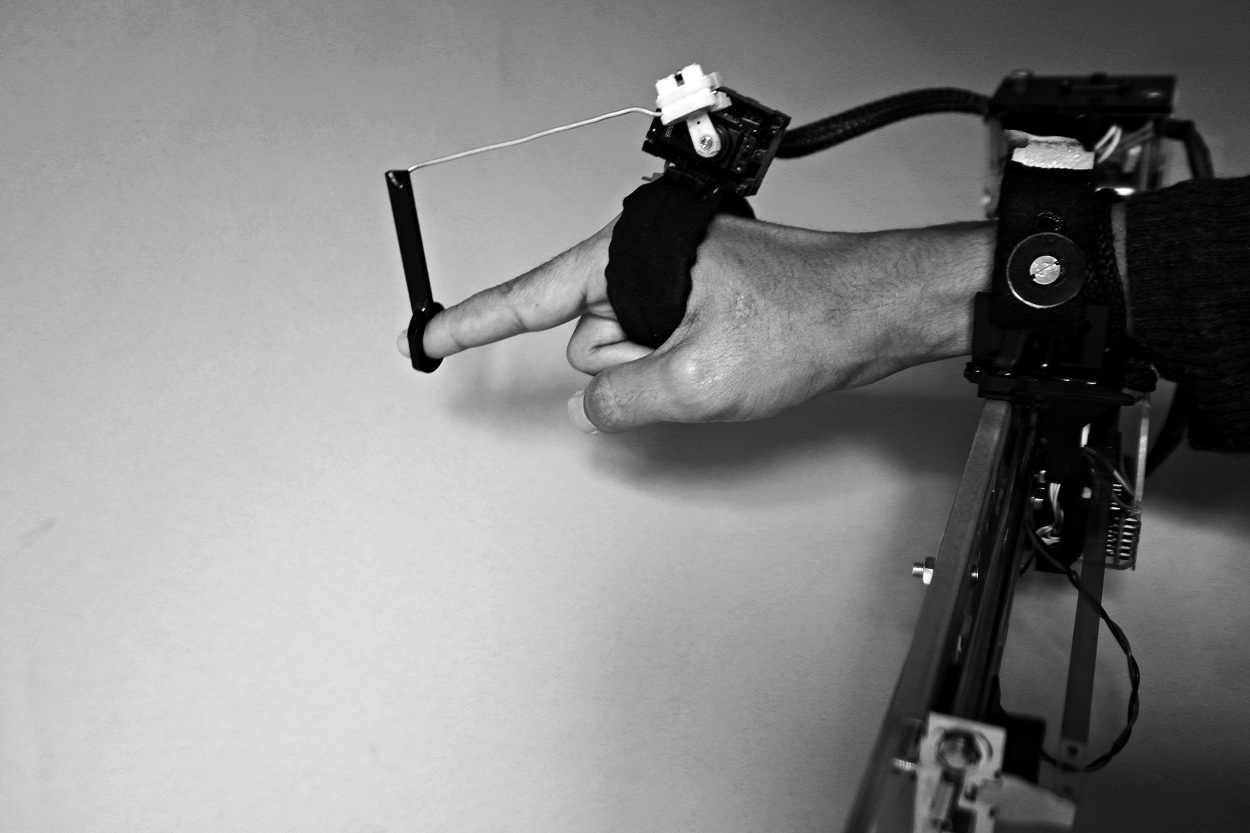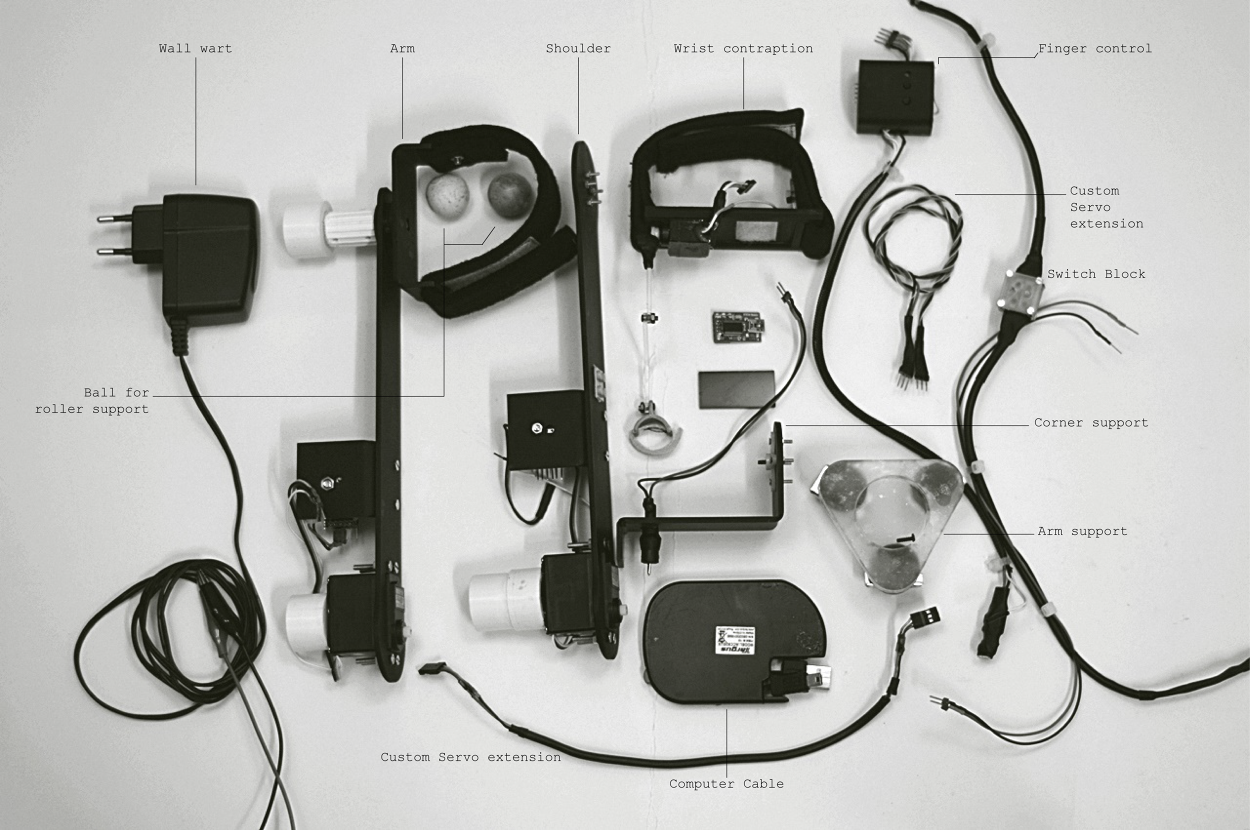Saurabh Datta's finger-forcing machine replicates the motion of striking piano keys. Images courtesy the artist, via
In Brave New World, select children living in London in the year 2540 are educated via hypnopædia, a process by which information is piped into their ears while they sleep. Due to biological and technological limitations, the idea of mainlining your Judo skills remains little more than science fiction. For one Copenhagen Institute of Interaction Design grad student, however, the real life science of neurofeedback sets the stage for a series of machines that could accelerate processes like drawing and playing an instrument by forcing parts of your body to go through the motions required to learn them.Inspired by projects such as Amid Moradganjeh's Haptic forestryand Kyle McDonald's Blind Self Portrait, as well as wearables and DIY robotics, Saurabh Datta set out to create a set of machines that apply force feedback and haptic response systems towards the acceleration of human understanding. "I remember when I started first learning alphabets my teachers used to hold my hand with the pen and trace on the paper multiple times, the letters," Datta told The Creators Project. "After letting me go I would do it over and over again and finally it achieved a muscle memory and I could do it by myself. I'm taking this metaphor of the importance of holding hands when learning a new skill." The first product of his research was a simple, technological solution designed to teach wearers how to touch piano keys: a servo motor-enabled contraption that strapped to the wrist and manipulated one finger with a lever. After the spectrum of responses to his device ranged from excitement about its potentials to distaste for being "forced" to perform physical maneuvers, Datta consolidated the idea into a brief for his thesis project: "I want to explore how we can use nuances of force feedback systems to learn new skills aided by developing muscle memory along the way. How can technology be used to support and elevate a muscle memory experience, if that's possible at all. More precisely I would like to see if it is suitable to use or is possible to use force feedback system to enhance fine motor muscle memory skills."
The first product of his research was a simple, technological solution designed to teach wearers how to touch piano keys: a servo motor-enabled contraption that strapped to the wrist and manipulated one finger with a lever. After the spectrum of responses to his device ranged from excitement about its potentials to distaste for being "forced" to perform physical maneuvers, Datta consolidated the idea into a brief for his thesis project: "I want to explore how we can use nuances of force feedback systems to learn new skills aided by developing muscle memory along the way. How can technology be used to support and elevate a muscle memory experience, if that's possible at all. More precisely I would like to see if it is suitable to use or is possible to use force feedback system to enhance fine motor muscle memory skills." The final result is Teacher, a machine that forces your arm to go through the motions of simple processes including drawing basic shapes like rectangles and circles. "I wanted to make the simplest machine which could fulfill as a working probe for the experiments. […] There are lot of drawbacks in the machine itself, like the people when put their hand in, their arms were suspended and not rested, this created a bit of tension." A self-described "lifelong tinkerer," Datta created and programmed three prototypes that employ parts from a hacked 3D printer as well as EMG nodes (to monitor user resistance) in a whopping 7 days.When it came to human/machine interaction, it wasn't all smooth sailing. During tense moments, people preferred to take control over the machine, explains Datta. For the learning devices of the future, he suggests that "The allocation and sharing of control between man and machine has to be versatile so that the sense of ownership and reliability is not much affected."The final products, however, show that there is indeed a strong potential for machines to teach us skills more efficiently. "The takeaway is technology that can provide more than a binary choice of 'either this… or nothing …'" Datta says, suggesting that finding a happy medium between robots we teach and robots we learn from has yet to be found. "We can be better in designing an enabling system rather than just service robots, systems that allow us to do things ourselves better or making us better in certain things rather than doing it for us all the time." But with Teacher selected for the TEI 2015 Student Design Challenge at Stanford University, we're already looking at a future of force-manipulated muscles with open arms.
The final result is Teacher, a machine that forces your arm to go through the motions of simple processes including drawing basic shapes like rectangles and circles. "I wanted to make the simplest machine which could fulfill as a working probe for the experiments. […] There are lot of drawbacks in the machine itself, like the people when put their hand in, their arms were suspended and not rested, this created a bit of tension." A self-described "lifelong tinkerer," Datta created and programmed three prototypes that employ parts from a hacked 3D printer as well as EMG nodes (to monitor user resistance) in a whopping 7 days.When it came to human/machine interaction, it wasn't all smooth sailing. During tense moments, people preferred to take control over the machine, explains Datta. For the learning devices of the future, he suggests that "The allocation and sharing of control between man and machine has to be versatile so that the sense of ownership and reliability is not much affected."The final products, however, show that there is indeed a strong potential for machines to teach us skills more efficiently. "The takeaway is technology that can provide more than a binary choice of 'either this… or nothing …'" Datta says, suggesting that finding a happy medium between robots we teach and robots we learn from has yet to be found. "We can be better in designing an enabling system rather than just service robots, systems that allow us to do things ourselves better or making us better in certain things rather than doing it for us all the time." But with Teacher selected for the TEI 2015 Student Design Challenge at Stanford University, we're already looking at a future of force-manipulated muscles with open arms.
 To learn more about Teacher, visit Saurabh Datta's website.Related:An Artist Has Made A Primitive Computer Out Of Earth Crystals, And Little Else"The Illusion Of Life" Machine Can Mimic Human WhispersArtist Turns A Record Player Into An Automatic IllustratorRobots That Create Art: Harvey Moon's Drawing Machines
To learn more about Teacher, visit Saurabh Datta's website.Related:An Artist Has Made A Primitive Computer Out Of Earth Crystals, And Little Else"The Illusion Of Life" Machine Can Mimic Human WhispersArtist Turns A Record Player Into An Automatic IllustratorRobots That Create Art: Harvey Moon's Drawing Machines
Advertisement

Advertisement

Advertisement


